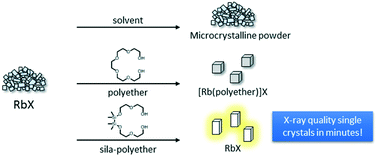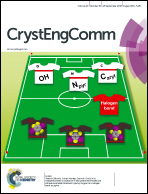Sila-polyethers as innocent crystallization reagents for heavy alkali metal compounds†
Abstract
In this study, we report on a novel approach for the crystallization of previously elusive rubidium and caesium salts. Stirring alkali metal salts in dichloromethane together with sila-polyethers such as 8,9-disila-EO5 (1) (EO5 = pentaethylene glycol), 11,12-disila-EO7 (2) (EO7 = heptaethylene glycol) and 1,2,10,11-tetrasila[18]crown-6 (3) under an inert-gas atmosphere yields crystalline materials of the respective salts suitable for single crystal diffraction analysis. This allowed the single crystal structure determination of the salts MOTf (M = Rb+, Cs+ and OTf = CF3SO3−) and Cs2Ox (Ox = C2O42−) whose structures had previously been solved from powder diffraction data. In contrast, the use of all-carbon polyethers like [18]crown-6 and EO5 under similar reaction conditions yields coordination compounds of the respective salts such as [M([18]crown-6)OTf], [Rb3(EO5)OTf3] (5) and [Cs(EO5)OTf] (6). This lets us conclude that it is the sila group in the polyethers that allows these ligands to act as a very efficient crystallization aid without being included in the final compound.



 Please wait while we load your content...
Please wait while we load your content...